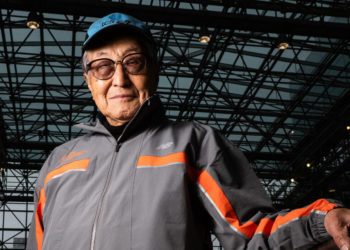Something was very wrong with Kyle and Nicole Muldoon’s baby.
The doctors speculated. Maybe it was meningitis? Maybe sepsis?
They got an answer when KJ was only a week old. He had a rare genetic disorder, CPS1 deficiency, that affects just one in 1.3 million babies. If he survived, he would have severe mental and developmental delays and would eventually need a liver transplant. But half of all babies with the disorder die in the first week of life.
Doctors at Children’s Hospital of Philadelphia offered the Muldoons comfort care for their baby, a chance to forgo aggressive treatments in the face of a grim prognosis.
“We loved him, and we didn’t want him to be suffering,” Ms. Muldoon said. But she and her husband decided to give KJ a chance.
Instead, KJ has made medical history. The baby, now 9 ½ months old, became the first patient of any age to have a custom gene-editing treatment, according to his doctors. He received an infusion made just for him and designed to fix his precise mutation.
The investigators who led the effort to save KJ are presenting their work on Thursday at the annual meeting of the American Society of Cell & Gene Therapy, and are also publishing it in the New England Journal of Medicine.
The implications of the treatment go far beyond treating KJ, said Dr. Peter Marks, who was the Food and Drug Administration official overseeing gene-therapy regulation until he recently resigned over disagreements with Robert F. Kennedy Jr., the secretary of health and human services. More than 30 million people in the United States have one of more than 7,000 rare genetic diseases. Most are so rare that no company is willing to spend years developing a gene therapy that so few people would need.
But KJ’s treatment — which built on decades of federally funded research — offers a new path for companies to develop personalized treatments without going through years of expensive development and testing.
Illnesses like KJ’s are the result of a single mutation — an incorrect DNA letter among the three billion in the human genome. Correcting it requires pinpoint targeting in an approach called base editing.
To accomplish that feat, the treatment is wrapped in fatty lipid molecules to protect it from degradation in the blood on its way to the liver, where the edit will be made. Inside the lipids are instructions that command the cells to produce an enzyme that edits the gene. They also carry a molecular GPS — CRISPR — which was altered to crawl along a person’s DNA until it finds the exact DNA letter that needs to be changed.
While KJ’s treatment was customized so CRISPR found just his mutation, the same sort of method could be adapted and used over and over again to fix mutations in other places on a person’s DNA. Only the CRISPR instructions leading the editor to the spot on the DNA with the mutation would need to be changed. Treatments would be cheaper, “by an order of magnitude at least,” Dr. Marks said.
The method, said Dr. Marks, who wrote an editorial accompanying the research paper, “is, to me, one of the most potentially transformational technologies out there.”
It eventually could also be used for more common genetic disorders like sickle cell disease, cystic fibrosis, Huntington’s disease and muscular dystrophy.
And, he said, it “could really transform health care.”
The story of KJ’s bespoke gene-editing treatment began on the evening of Aug. 8, when Dr. Kiran Musunuru, a gene-editing researcher at the University of Pennsylvania got an email from Dr. Rebecca Ahrens-Nicklas at the Children’s Hospital of Philadelphia. A baby had been born, and genetic testing showed he had CPS1 deficiency.
Could he save the baby?
Dr. Musunuru had begun investigating the use of gene editing for fairly common gene mutations.
Developing a gene editor to treat patients is a deliberate process that can take years. But KJ did not have years to wait — perhaps as few as six months before a mounting risk of severe brain damage or death.
“At this point, the clock starts in my mind,” Dr. Musunuru said. “This is real life. This is not hypothetical.”
KJ’s disease is caused by an inability to rid the body of ammonia, a byproduct of protein metabolism. Ammonia builds up in the blood and crosses into the brain. His doctors put him on a diet that severely restricted protein — just enough for him to grow. He also had a medicine, glycerol phenylbutyrate, that helped remove the ammonia in his blood. But he still was at high risk for brain injury or death. Any illness or infection could make his ammonia levels soar and cause irreversible damage to his brain.
KJ lived at the hospital under 24-hour care.
Building a gene-editing system for the Muldoons’ baby and testing it was not easy.
“There was a lot of shooting from the hip,” Dr. Musunuru said.
He began working with Fyodor Urnov at the University of California, Berkeley, who made sure there were no unexpected and deleterious gene edits elsewhere in the DNA. Dr. Urnov is a part of an academic collaboration with Danaher Corporation, a company capable of producing the gene editor for KJ at a standard that would allow it to be used in a patient.
Danaher in turn collaborated with two other companies it owned, two additional biotechnology firms and another research institute, said Sadik Kassim, its chief technology officer for genomic medicines.
“At every step of the process, we were always expecting someone to say, ‘No, sorry,’” Dr. Kassim said. “And that would be the end of the story.” But his fears were unfounded. Danaher and the other companies charged only for the raw materials to make the drug, he added.
The F.D.A. also smoothed regulatory approval of the treatment, Dr. Ahrens-Nicklas said.
Dozens of researchers put all else aside for months.
In Berkeley, Dr. Urnov said, “scientists burned a vat of midnight oil on this the size of San Francisco Bay.” He added that “such speed to producing a clinic-grade CRISPR for a genetic disease has no precedent in our field. Not even close.”
David Liu of Harvard, whose lab invented the gene-editing method used to fix KJ’s mutation, said the speed was “astounding.”
“These steps traditionally take the better part of a decade, if not longer,” he said.
Only when the gene-editing solution was in hand and the F.D.A. approved the researchers’ work did Dr. Ahrens-Nicklas approach KJ’s parents.
“One of the most terrifying moments was when I walked into the room and said, ‘I don’t know if it will work but I promise I will do everything I can to make sure it is safe,’” she said.
On the morning of Feb. 25, KJ received the first infusion, a very low dose because no one knew how the baby would respond. He was in his room, in the crib where he had lived his entire life. He was 6 months old and in the seventh percentile for his weight.
Dr. Musunuru monitored the two-hour infusion, feeling, he said, “both excited and terrified.”
KJ slept through it.
Within two weeks, KJ was able to eat as much protein as a healthy baby. But he still needed the medication to remove the ammonia from his blood — a sign that the gene editor had not yet corrected the DNA in every affected cell.
The doctors gave him a second dose 22 days later.
They were able to halve the medication dose. He got a few viral illnesses in that time, which normally would have triggered terrifying surges in his ammonia levels. But, Dr. Ahrens-Nicklas said, “he sailed through them.”
A week and a half ago, the team gave KJ a third dose.
It is too soon to know if he can stop taking the medication completely, but the dosage is greatly reduced. And he is well enough for the team to start planning to discharge him home from the hospital. He is meeting developmental milestones and his weight is now in the 40th percentile for his age, but it is not yet known if he’ll be spared a liver transplant.
The result “is a triumph for the American peoples’ investment in biomedical research,” Dr. Urnov said.
The researchers emphasized the role government funding played in the development.
The work, they said, began decades ago with federal funding for basic research on bacterial immune systems. That led eventually, with more federal support, to the discovery of CRISPR. Federal investment in sequencing the human genome made it possible to identify KJ’s mutation. U.S. funding supported Dr. Liu’s lab and its editing discovery. A federal program to study gene editing supported Dr. Musunuru’s research. Going along in parallel was federally funded work that led to an understanding of KJ’s disease.
“I don’t think this could have happened in any country other than the U.S.,” Dr. Urnov said.
Those who worked on saving KJ were proud, Dr. Urnov said.
“We all said to each other, ‘This is the most significant thing we have ever done.’”
Gina Kolata reports on diseases and treatments, how treatments are discovered and tested, and how they affect people.
The post Baby Is Healed With World’s First Personalized Gene-Editing Treatment appeared first on New York Times.




